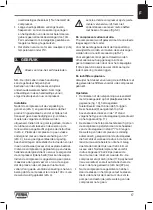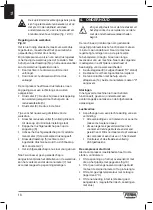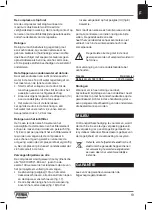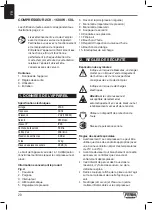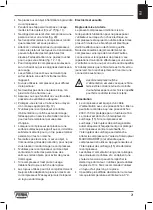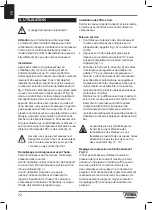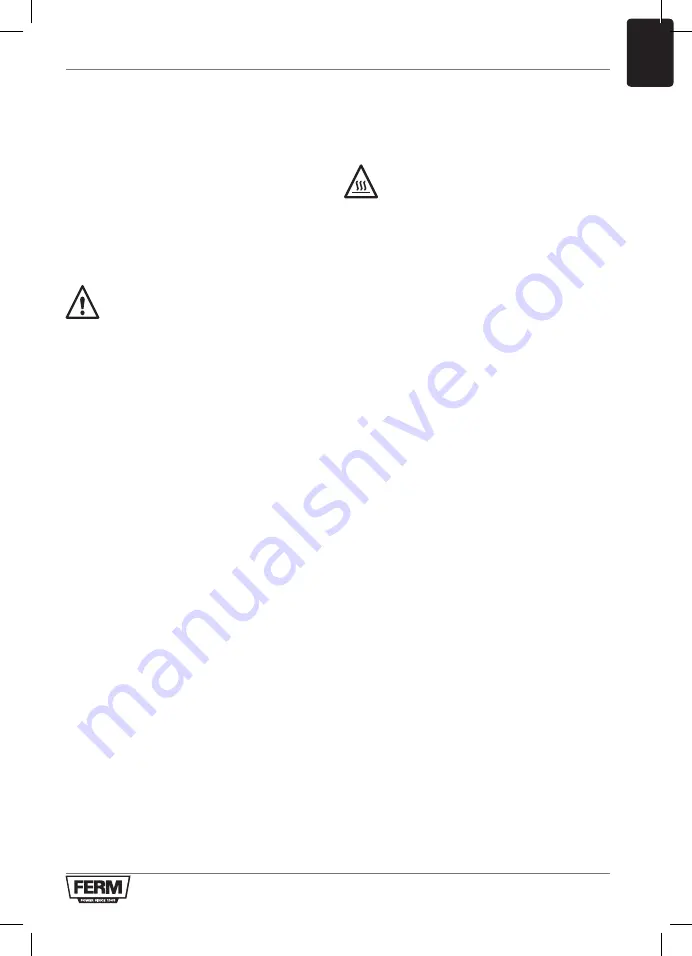
7
EN
to the instructions represented in fig. 2. Place the
compressor on a flat surface or at a maximum slope
of 10° (fig.3), in a well ventilated area, protected
against atmospheric factors and not in explosive
surroundings. If the surface area is sloping and
smooth, make sure that the compressor will not
move when in operation. If the surface area is a
board or a shelf of a bookcase, just make sure that
they cannot fall down by securing them properly.
For proper ventilation and effective cooling, it is
important that the compressor is positioned at least
100 cm from the wall (fig. 4).
Make sure that the compressor is
transported in the right way, do not turn it
upside down and don’t lift it with hooks
or ropes (fig. 5-6).
filling the compressor with oil.
Your compressor is supplied with oil which is
already included in the carter.
Before use, remove the transport cap on the carter
(12), and replace it by the regular oil cap (fig 7).
Before use, ensure that oil level is sufficient.
This can be checked by checking the oil
inspection glass (13). When compressor is placed
horizontally, the oil level shall reach the red mark.
installing the air filters.
Remove the transport lids and replace them with
the supplied air filters before using the compressor.
Starting up
• Check whether the mains voltage corresponds
to that indicated on the electrical specification
plate (fig. 10), the permitted tolerance range
should be within 5%.
• Press the switch (3) situated on the upper part
into the “0” position according to the pressure
regulator type fitted on the device (fig. 11).
• Put the plug in the plug socket (fig. 9) and start
the compressor up by putting the switch(3)
of the pressure regulator in the “I” position.
The operation of the compressor is fully
automatic. The pressure regulator will stop
the compressor when the maximum value has
been reached and start it up when the pressure
drops below the minimum value. Normally
the difference in pressure is approx. 2 Bar/29
psi between the maximum and the minimum
value. For instance - The compressor will stop
when it reaches 8 Bar (116 psi) (this is the
maximum operating pressure) and will start
up automatically when the pressure within the
tank has dropped to 6 Bar (87 psi).
The head/cylinder/transmission pipe
assembly may reach high temperatures,
so take care when working close to these
parts and do not touch them to avoid
burns (fig. 12 - 13).
adjusting the operating pressure
Fig. 14
It is not necessary continuously to use the
maximum operating pressure, the compressed-air
tools often require less pressure. With regard to
compressors supplied with a pressure reduction
valve it is necessary to set the operating pressure
properly.
It is possible to set the operating pressure by
using the turning knob(5) on the reduction valve.
• By turning clockwise, the pressure will be
increased.
• By turning anti-clockwise, the pressure will be
reduced.
The compressor has two pressure gauges and
one point to connect an air hose:
• Pressure gauge (7): The pressure of this outlet
can be regulated with help of the reduction
valve (5).
• Pressure gauge (8): tank pressure
Hints for accurate adjustment of the pressure
regulation:
• Turn the turning knob (5) anti-clockwise till
pressure is fully released
• Connect the air tool you want to use to the
quick coupler (6)
• Activate the air tool shortly, so the pressure
gauge (7) will show the right pressure level
• Turn the turning knob (5) clockwise, till the
pressure gauge (7) shows the pressure level
you need
• Your air tool is now ready to use.
Note: when not connecting an air tool while
adjusting the pressure, it might occur the pressure
gauge (7) is not reacting accurately on the
pressure drop.
Summary of Contents for CRM1046
Page 2: ...2 Fig A...
Page 3: ...3...
Page 4: ...4...
Page 26: ...26 BG 3 0 OFF 11 20 N B 12 13 5 6 21 230 50 16 15 ON OFF 3...
Page 27: ...27 BG 15 10 Ferm 0 C 3 NB 1 2 100 3 10 cm 4 5 6 12 7 13 10 5 0 11 9 I 2 bar 8 bar 6 bar...
Page 28: ...28 BG 12 13 14 7 5 8 5 6 7 5 7 7 4 3 0 0 0 1 5 14...
Page 29: ...29 BG 10 00 1 2 bar 16 2 10 50 15 SAE 10W30 100 13 17 18 13 8 SAE 10W30 100 6...
Page 30: ...30 BG...
Page 52: ...52 UK 3 0 OFF 11 20 12 13 5 6 a b c 21 0 C 2 5 2 20...
Page 53: ...53 UK 230 50 16A 15 3 15 10 Ferm 0 C 3 3 1 2 10 3 100 4 5 6 12 7 13 10 5 0 11 9 I...
Page 54: ...54 UK 2 29 8 116 6 87 12 13 14 5 7 5 8 5 6 7 5 7 7 4 3 0 0 1 5 14...
Page 55: ...55 UK 10 0 C 8 16 2 14 1 2 50 15 SAE 10W30 100 13 17 18 13 8 SAE 10W30 100 6...
Page 56: ...56 UK...
Page 58: ...58 MK 3 0 OFF 11 20 12 13 5 6 a b c 21 230V 50Hz 16A 15 3 15 10 m FERM...
Page 60: ...60 MK 5 7 5 8 5 6 7 5 7 7 4 0 0 bar 1 5 bar 14 10 0 C...
Page 61: ...61 MK 16 2 bar 14 max 1 2 bar 50 15 SAE 10W30 100 13 17 18 13 8 SAE 10W30 100 6...
Page 62: ...62 MK...
Page 63: ...63 MK...
Page 65: ...65 Exploded view...
Page 66: ...66...

















